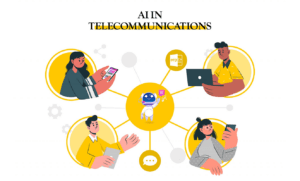The telecommunications industry is under pressure to meet the ever-growing demand for data services. Along with this pressure comes the need to find ways to improve efficiency and reduce costs. One way that telecom companies are looking to do this is by leveraging artificial intelligence (AI). AI can be used in a number of ways in the telecom industry, including network optimization, chatbots, and fraud detection. However, there are also a number of challenges that need to be addressed before AI can be fully adopted by telecom companies. In this blog post, we will explore the opportunities and challenges of AI in telecommunications. We will also look at some examples of how AI is being used in the telecom industry today.

The added value of AI in telecom
The article discusses the opportunities and challenges that artificial intelligence (AI) presents for the telecommunications industry. It notes that AI can help telecom operators to improve their customer experience, manage network resources more effectively, and prevent fraud. However, the article also highlights some of the challenges that AI poses for telecom operators, such as the need to invest in data infrastructure and staff training, and the risk of vendor lock-in.
Open challenges in AI for telecom businesses
In the previous section, we discussed some of the key opportunities that AI presents for telecom businesses. In this section, we will focus on some of the challenges that need to be addressed in order for these opportunities to be fully realized.
One of the biggest challenges is data quality and quantity. In order for AI models to be effective, they need high-quality data. This data is often difficult to come by in the telecom industry due to the proprietary nature of many networks and systems. In addition, the data that is available is often unstructured and unorganized, making it difficult to use for training AI models.
Another challenge is the lack of expertise. Many telecom businesses do not have the necessary expertise internally to develop and deploy AI solutions. This lack of expertise can make it difficult to identify which solution providers are reputable and which ones are not.
Finally, another challenge that needs to be addressed is regulatory uncertainty. The Telecom Regulatory Authority of India (TRAI) has been slow to release guidelines on how AI can be used in the telecom sector. This regulatory uncertainty has made it difficult for telecom businesses to experiment with AI and deploy solutions at scale.
Pain areas of applying AI in telecom
There are many potential pain areas when applying AI in telecom. One area is managing the data required to train AI models. Telecom companies generate large amounts of data, but it is often unstructured and spread out across different systems. Another challenge is dealing with the complex and dynamic nature of telecom networks.
AI can help telecom companies automate tasks and make decisions, but it can also introduce new risks and complexities. For example, AI-based systems may not be able to explain their decisions, which could lead to regulatory problems. Additionally, if not managed properly, AI could result in increased customer churn as customers move to competitors that offer a better experience.
AI for telecom: Real-life examples
In recent years, AI has been increasingly applied to the telecom industry with great success. Here are some real-life examples of how AI is being used in telecom today:
- Call center automation: AI is being used to automate call center operations, including customer service, support, and sales. This is enabling telecom companies to improve efficiency and reduce costs.
- Network management: AI is being used to manage and optimize telecom networks. This includes tasks such as network planning, provisioning, and troubleshooting.
- Fraud detection: AI is being used to detect and prevent fraud in the telecom industry. This includes identifying fraudulent call patterns, billing irregularities, and other suspicious activity.
- Customer analytics: AI is being used to analyze customer data for insights that can help improve customer retention and satisfaction. This includes analyzing customer usage patterns, preferences, and demographics.
The future of telecommunications is powered by artificial intelligence (AI).
This technology is already being used by telecom providers to improve customer service, prevent fraud, and optimize networks. In the future, AI will become even more important as 5G networks and the Internet of Things (IoT) create new opportunities for telecom companies.
There are many challenges that need to be addressed before AI can realize its full potential in telecommunications. These include data privacy concerns, the need for better data governance, and the lack of skilled AI personnel. However, these challenges can be overcome with the right policies and investments.
The opportunities presented by AI are too great to ignore. Telecom companies that embrace this technology will be well-positioned to succeed in the years to come.
The Final word
As the telecommunications industry evolves, so too does the role of artificial intelligence (AI). AI is increasingly being used to help manage networks, optimize resources, and improve customer experience. While there are many opportunities for AI in telecommunications, there are also challenges that need to be addressed.
In this blog article, we will explore some of the challenges and opportunities associated with AI in telecommunications. We will also touch on some of the ethical considerations that need to be taken into account when using AI in this industry.

This site is amazing and full of valuable information. Keep up the good work.